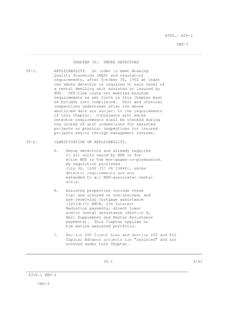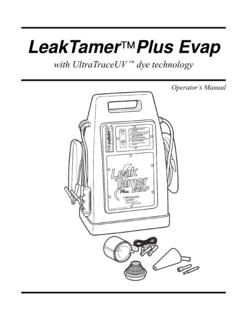Transcription of How To Smoke Fish - Southern California Ocean …
1 How To Smoke FishBy Jeff SpiraSpira International, Inc. - Huntinfton Beach, CaliforniaHow To Smoke Fishby Jeff SpiraPublished bySpira International, IncHuntington Beach, CaliforniaCopyright 2007 by Jeffrey. J. SpiraAll Rights ReservedThis document may not be reproduced, in whole or in part, in any form, without the priorwritten consent of the copyright THAT FISHS moking fish is a practice that s probably as old as man himself. Long ago in some cave, it wasmost likely discovered by accident. A fish hanging in the vicinity of fire acquired a delectable the discoverer s delight when he first tasted it!
2 He probably also discovered that the smoked fishlasted far longer without spoiling than fresh fish or even cooked discovered the process, there is no doubt that the practice had a long and lasting effect onfood preparation and preservation ever since. Practically every nationality of people in the world has aspecialized smoking method for fish . From the French royal courts, to the African jungles, to the SouthAmerican Indian s homes, to the Igloos of the Eskimos to the homes of the Japanese Samurai, smoked fishhas been a favorite fare for a special the time Europeans began immigrating to the new world, smoking foods was considered nor-mal.
3 Practically every home had a smokehouse in the back yard. Those that didn t had a special chamberin the fireplace chimney so that foods could be smoked while the nightly fire provided warmth and light forthe in those days was considered a preservation method for foods, not just a flavor this reason, smoking foods as a process nearly dropped out of sight by the time ice boxes, refrigeratorsand freezers became commonplace. Smoked fish , though, kept its appeal supported by ethnic preferencesand long standing tradition. The English country squire simply wouldn t be without his kippered (smoked)herring for breakfast. Jewish families revered their lox (smoked salmon) and smoked whitefish.
4 Japanesewould make ahi himono (smoked jack mackerel) whenever the fish was available to preserve it in times itwasn t. Indians and Eskimos of the American northwest continued smoking their salmon even when betterpreservation methods became recent advent of the portable electric smoker has caused a renewed interest in smoked fish andhas brought the practice of smoking fish and other foods into the homes of millions of Americans. Face it,the tastes of most people is growing. If you had offered sushi to many people in 1970, they would haveprobably turned up their noses in disgust. These are the same people that spend every Friday night in asushi bar in 2000.
5 To most people when they grew up, eating fish meant eating fried fish . All of that ischanging. fish is now broiled, poached, baked, barbequed, poached, pickled, and yes, even can recall with some humor back a number of years ago when my father came home with one ofthe first portable electric smokers. He and I used to often go Ocean fishing and we d always either eat rightaway or freeze our catch. We had been desperately trying to find a way to cook the local mackerel andbonito so that it wasn t so the little smoker. The rest ofthe family giggled while he set it up,brined some fish and got ready forthe first home smoked , he pressed on for thefirst test smoking of some wholemackerel, some steaks of barracudaand some fillets of bonito.
6 The re-sults were nothing less than fantas-tic. I simply couldn t believe thatthe junk fish that everyone elsefed to their cats or buried in theirgardens could be so flavorful. Sincethen I ve been an avid fish smokerand aji SMOKING PROCESSS moking of foods, especially fish does far more than simply alter the flavor of the food. All meats,including fish contain a lot of water. Some fish contains as much as eighty percent water! Water is thebasic breeding ground for yeasts, molds and bacteria. Prior to smoking fish , the fish must be brined, orsalted. This process is not for actually salting the food for flavor, since the finished product actuallycontains very little salt, but rather for pulling much of the excess moisture out of the smoking itself actually dries out the meat more than the brining in much the same way ascooking does.
7 So once the fish has been salted, then smoked, only a tiny fraction of the original watercontent of the meat remains. This in itself offers a considerable increase in nutritional value because themeat is less water and more actual protein as well as offering a level of preservation to the Smoke contains many chemicals that were once part of the life process of the living these chemicals are driven out of the wood, the fish hanging in the Smoke absorbs them. Thisprocess of driving the chemicals out of the wood is called destructive distillation. It is the process thatconverts wood to charcoal. In the smoker, the wood chemicals are first driven out of the wood and then theremaining charcoal powder burns just like in your barbeque.
8 The natural chemicals in hardwood smokehave the added benefit of both killing and inhibiting the future growth of mold, yeasts and bacteria. Thesechemicals are the basic reason for the preservation power of the smoking are actually two different smoking methods. The first and original is called cold smoking. Ina cold smoker, the temperature is generally below 120 degrees F. This is the classic smokehouse methodthat was used by most people before refrigerators. Cold smoked meats and fish require cooking eitherbefore or after smoking. Cold smoking takes a lot of time, too. You can hang a ham in a smokehouse andsmoke it with the cold smoking process for three or four days before a good Smoke flavor is infused into themeat.
9 The ham must then be cooked before modern method for smoking, especially suitable for fish , is the hot smoking process. Hotsmoking takes place at temperatures exceeding 140 degrees F. This 140 F temperature is important be-cause it is the temperature that kills all undesirable bacteria. Milk is pasteurized at 140 F to kill anybacteria and render it suitable for storage for a while before it is consumed. In the hot smoking process, thefish is actually cooked while it is smoking fish has many advantages. It can be done fairly quickly, in 2 to 4 hours for most cutsand no additional cooking is required.
10 The fish may be eaten as soon as it comes cut of the smoker. It alsokeeps very well. No refrigeration is required for a day or so, if you want to take some along on a fishingtrip, but you should refrigerate it to make it last longer. All of the smoked fish you see in the fish marketsnowadays is hot one will admit faster than I that fish is smoked in all sorts of devices. I ve seen cardboard boxsmokers, smokers made from old refrigerators, fancy brick smokers, even smokers made from garbagecans. I m not sure how these all worked but I m sure Smoke got to the food in all of them. The mostpractical smoker for fish is the trusty electric hot smoker.







